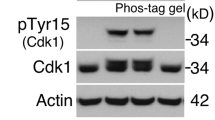Abstract
Protein phosphorylation is involved in many biological activities and plays important roles in cell cycle progression. In the present study, we identified a serine/threonine kinase, hAIK, from human hepatic cells using degenerated polymerase chain reactions with a pair of primers derived from the highly conserved sequence in the catalytic domain of kinases. The full-length hAIK cDNA was then obtained, which contained 403 amino acids and was homologous toDrosophila Aurora2 and yeast Ipl1 proteins. Northern blotting analysis revealed that hAIK was highly expressed in the testis but not in other tissues. Expressions of hAIK drastically increased in cancer tissues/cell lines but not in fibroblasts or nontumorigenic cell lines. The recombinant hAIK protein phosphorylated itself and histone H1; this phosphorylation activity was totally abolished after a point mutation at the catalytic domain (hAIKm). During the interphase cell, hAIK was found mainly in the cytoplasm; during mitosis hAIK accumulated at the centrosomes. In addition, over-expression of hAIK in cancer cell lines (HEK293T and HeLa) appeared to inhibit cell cycle progression. None of these phenomena were observed in hAIKm whose kinase activity was rendered inactive. Our results suggest that hAIK protein/activity might modulate cell cycle progression by interacting with the centrosomes and/or proteins associated with these structures.
Similar content being viewed by others
References
Albrecht JH, Rieland BM, Nelsen CJ, Ahonen CL. Regulation of G(1) cyclin-dependent kinases in the liver: Role of nuclear localization and p27 sequestration. Am J Physiol 277:G1207-G1216;1999.
Biggins S, Severin FF, Bhalla N, Sassoon I, Hyman AA, Murray AW. The conserved protein kinase Ipl1 regulates microtubule binding to kinetochores in budding yeast. Genes Dev 13:532–544;1999.
Bischoff JR, Plowman GD. The Aurora/Ipl1p kinase family: Regulators of chromosome segregation and cytokinesis. Trends Cell Biol 9:454–459;1999.
Cahill DP, Lengauer C, Yu J, Riggins GJ, Willson JK, Markowitz SD, Kinzler KW, Vogelstein B. Mutations of mitotic checkpoint genes in human cancers. Nature 392:300–303;1998.
Chan CS, Botstein D. Isolation and characterization of chromosome-gain and increase-in-ploidy mutants in yeast. Genetics 135:677–691;1993.
Dictor M, Ehinger M, Mertens F, Akervall J, Wennerberg J. Abnormal cell cycle regulation in malignancy. Am J Clin Pathol 112:S40-S52;1999.
Doxsey S. The centrosome — a tiny organelle with big potential. Nat Genet 20:104–106;1998.
Farruggio DC, Townsley FM, Ruderman JV. Cdc20 associates with the kinase aurora2/Aik. Proc Natl Acad Sci USA 96:7306–7311;1999.
Francisco L, Wang W, Chan CS. Type 1 protein phosphatase acts in opposition to IpL1 protein kinase in regulating yeast chromosome segregation. Mol Cell Biol 14:4731–4740;1994.
Glisin V, Crkvenjakov R, Byus C. Ribonucleic acid isolated by cesium chloride centrifugation. Biochemistry 13:2633–2637;1974.
Glover DM, Leibowitz MH, McLean DA, Parry H. Mutations in aurora prevent centrosome separation leading to the formation of monopolar spindles. Cell 81:95–105;1995.
Huang AM, Chang TJ, Cho WL, Chou CK. From mosquito to man: Identification of a novel protein kinase, HsHPK, which is highly expressed in human hepatoma tissues. J Biomed Sci 5:135–140;1998.
Hunter T. Signaling — 2000 and beyond. Cell 100:113–127;2000.
Hunter T. A thousand and one protein kinases. Cell 50:823–829;1987.
Kimura M, Kotani S, Hattori T, Sumi N, Yoshioka T, Todokoro K, Okano Y. Cell cycle-dependent expression and spindle pole localization of a novel human protein kinase, Aik, related to Aurora of Drosophila and yeast Ipl1. J Biol Chem 272:13766–13771;1997.
Kramer ER, Gieffers C, Holzl G, Hengstschlager M, Peters JM. Activation of the human anaphase-promoting complex by proteins of the CDC20/Fizzy family. Curr Biol 8:1207–1210;1998.
Lengauer C, Kinzler KW, Vogelstein B. Genetic instabilities in human cancers. Nature 396:643–649;1998.
Li J, Meyer AN, Donoghue DJ. Nuclear localization of cyclin B1 mediates its biological activity and is regulated by phosphorylation. Proc Natl Acad Sci USA 94:502–507;1997.
Li J, Meyer AN, Donoghue DJ. Requirement for phosphorylation of cyclin B1 forXenopus oocyte maturation. Mol Biol Cell 6:1111–1124;1995.
Lian WN, Tsai JW, Yu PM, Wu TW, Yang SC, Chau YP, Lin CH. Targeting of aminopeptidase N to bile canaliculi correlates with secretory activities of the developing canalicular domain. Hepatology 30:748–760;1999.
Mayor T, Meraldi P, Stierhof YD, Nigg EA, Fry AM. Protein kinases in control of the centrosome cycle. FEBS Lett 452:92–95;1999.
Morgan DO. Cyclin-dependent kinases: engines, clocks, and microprocessors. Annu Rev Cell Dev Biol 13:261–291;1997.
Norbury C, Nurse P. Animal cell cycles and their control. Annu Rev Biochem 61:441–470;1992.
Pawson T. Introduction: protein kinases. FASEB J 8:1112–1113;1994.
Peters JM. SCF and APC: The Yin and Yang of cell cycle regulated proteolysis. Curr Opin Cell Biol 10:759–768;1998.
Roghi C, Giet R, Uzbekov R, Morin N, Chartrain I, Le Guellec R, Couturier A, Doree M, Philippe M, Prigent C. TheXenopus protein kinase pEg2 associates with the centrosome in a cell cycle-dependent manner, binds to the spindle microtubules and is involved in bipolar mitotic spindle assembly. J Cell Sci 111:557–572;1998.
Shevelyov YY. Aurora, a non-mobile retrotransposon inDrosophila melanogaster heterochromatin. Mol Gen Genet 239:205–208;1993.
Shindo M, Nakano H, Kuroyanagi H, Shirasawa T, Mihara M, Gilbert DJ, Jenkins NA, Copeland NG, Yagita H, Okumura K. cDNA cloning, expression, subcellular localization, and chromosomal assignment of mammalian aurora homologues, aurora-related kinase (ARK) 1 and 2. Biochem Biophys Res Commun 244:285–292;1998.
Tseng TC, Chen SH, Hsu YP, Tang TK. Protein kinase profile of sperm and eggs: Cloning and characterization of two novel testis-specific protein kinases (AIE1, AIE2) related to yeast and fly chromosome segregation regulators. DNA Cell Biol 17:823–833;1998.
Uchiumi T, Longo DL, Ferris DK. Cell cycle regulation of the human polo-like kinase (PLK) promoter. J Biol Chem 272:9166–9174;1997.
Yang J, Kornbluth S. All aboard the cyclin train: Subcellular trafficking of cyclins and their CDK partners. Trends Cell Biol 9:207–210;1999.
Zhou H, Kuang J, Zhong L, Kuo WL, Gray JW, Sahin A, Brinkley BR, Sen S. Tumour amplified kinase STK15/BTAK induces centrosome amplification, aneuploidy and transformation. Nat Genet 20:189–193;1998.
Author information
Authors and Affiliations
Rights and permissions
About this article
Cite this article
Yang, SC., Huang, CH., Chen, NJ. et al. Functional implication of human serine/threonine kinase, hAIK, in cell cycle progression. J Biomed Sci 7, 484–493 (2000). https://doi.org/10.1007/BF02253364
Received:
Accepted:
Issue Date:
DOI: https://doi.org/10.1007/BF02253364




